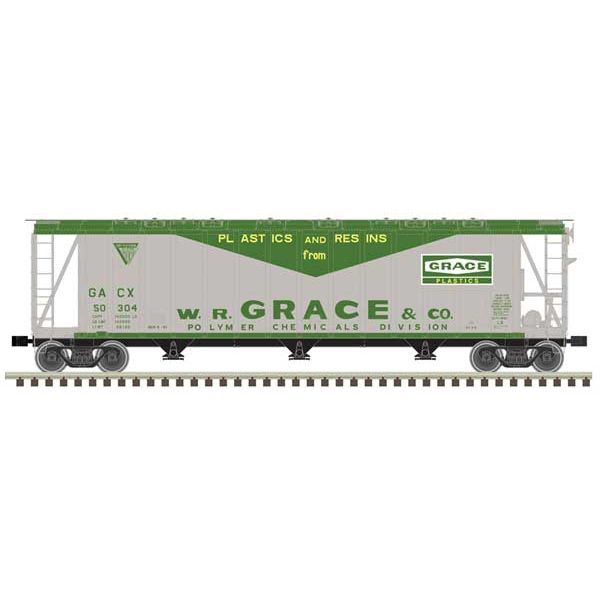
Atlas, N Scale, 50006344, General American 3500 Dry-Flo 3-Bay Covered Hopper, WR Grace GACX, #50234
- Low stock - 1 item left
Atlas, N Scale, 50006344, General American 3500 Dry-Flo 3-Bay Covered Hopper, WR Grace GACX, #50234
Description The 3500 Cubic Foot Dry-Flo Covered Hopper served as a reliable commodity hauler for over four decades. In 1959, General American initiated the production of Dry-Flo covered hoppers to meet the rising demand for larger hoppers capable of handling bulk commodities. The innovations in covered hopper design during the 1950s were greatly beneficial to shippers, who sought hoppers that could accommodate larger quantities of specialized commodities like oats and malt. The N Scale Dry-Flo model is meticulously crafted to match the prototype down to the finest detail, using original prototype blueprints. Atlas ensures accurate attention to both body and paint detail.
Production History:
-
Built: The GA 3500CF Dry-Flo Covered Hoppers were manufactured primarily during the 1960s and 1970s.
-
Quantity: While exact production numbers are not readily available, thousands of these tank cars were produced to meet the demands of various industries.
-
Replacement Timeline: These tank cars began to be gradually replaced starting in the late 1980s and early 1990s as newer models with improved safety and efficiency features were introduced.
-
Current Status: Many of these tank cars have been retired from active service, but some are still in use today, primarily for specialized or regional applications.
Features:
-
Ready-to-Run
-
Injection-Molded Plastic
-
Fine-Scale Detail
-
Separate Brake Detail
-
Chemically Etched Brake Platform
-
Accurately Painted/Printed
-
Prototypical Ride Height
-
70-Ton ASF Ride Control Trucks
-
33" Metal Wheels
-
Body-Mounted Scale Coupler
Pointless information I liked about the company:
W. R. Grace & Company's Polymer Chemicals Division: Innovating Plastics and Resins
W. R. Grace & Company, a leading global specialty chemical company, has a dedicated Polymer Chemicals Division that focuses on providing advanced catalysts and materials for the production of plastics and resins. This division is known for its innovative solutions that enhance the performance, efficiency, and sustainability of plastic manufacturing processes.
Advanced Catalyst Technologies
The Polymer Chemicals Division offers a range of catalyst technologies designed to improve plant reliability and target high-end growth applications. Their UNIPOL® PP Process Technology is renowned for its reliability and efficiency in polypropylene (PP) production. Additionally, their ActivCat® Catalysts and CONSISTA® Catalysts provide breakthrough activation technology and differentiated product performance for polyethylene (PE) and PP resins.
Environmental Sustainability
Grace is committed to meeting environmental sustainability requirements and helping customers achieve their sustainability goals. Their catalysts and process technologies are designed to reduce environmental impact while maintaining high performance.
Hauling in Covered Hoppers
The GA 3500CF Dry-Flo Covered Hopper, produced by General American Transportation Corporation (GATX), was a backbone for hauling bulk commodities for over 40 years. These covered hoppers were designed to handle larger quantities of specialized commodities such as oats, malt, rice, plastic pellets, soybeans, spent grain, petroleum coke, corn products, bentonite, and various milled products. The Dry-Flo family of cars, including the Dry-Flo, Dry-Flo Chem, and Dia-Flo models, featured gravity-pneumatic or pneumatic-only discharge options, making them versatile and efficient for various industries[1]
Legacy and Impact
The GA 3500CF Dry-Flo Covered Hoppers were built primarily during the 1960s and 1970s, with thousands produced to meet the demands of various industries. These hoppers began to be gradually replaced starting in the late 1980s and early 1990s as newer models with improved safety and efficiency features were introduced. Despite their retirement from active service, some of these hoppers are still in use today for specialized or regional applications.
W. R. Grace & Company's Polymer Chemicals Division continues to innovate and provide solutions that support the plastics and resins industry, ensuring long-term success and sustainability for their customers.

